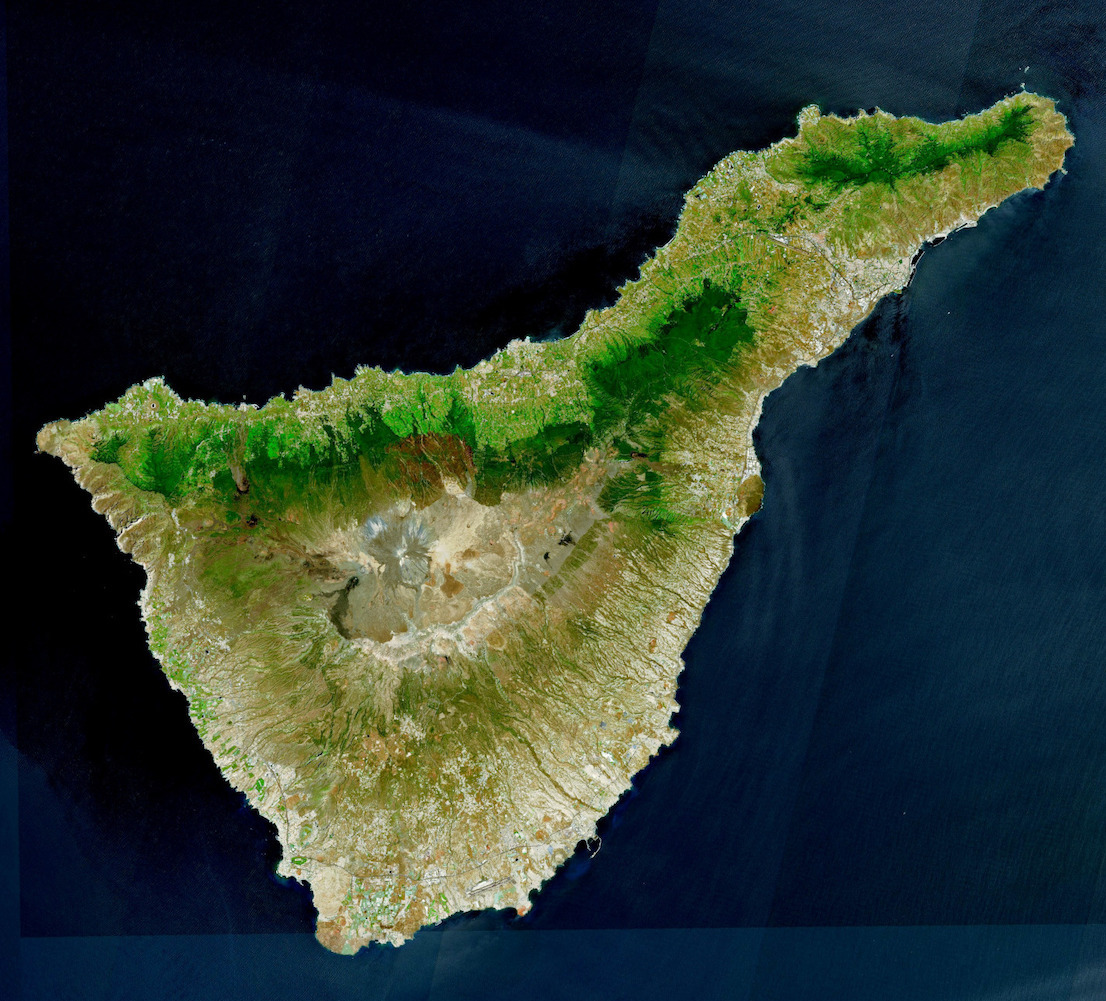|
Guayota
Guayota, in Guanche mythology of Tenerife (the Canary Islands), was the principal malignant deity and Achamán's adversary. Mythology According to Guanche legend, Guayota lived inside the Teide volcano, one of the gateways to the underworld. He was said to be represented as a black dog and was accompanied by demons, also in the form of black dogs, known as tibicenas. According to legend, Guayota kidnapped Magec (the sun) and shut it up in Teide, plunging the world into darkness. Humans prayed to Achamán who saved Magec and instead locked Guayota up in Teide. Guayota is the king of evil genies, and was part of Guanche mythology. Features Guayota shares features similar to other malignant deity-inhabitants of volcanoes as in the case of the goddess Pele in Hawaiian mythology, who lived in the Kīlauea volcano and was regarded by the native Hawaiians as responsible for the eruptions of the volcano. In popular culture Currently, like other aboriginal gods, Guayota remains a ... [...More Info...] [...Related Items...] OR: [Wikipedia] [Google] [Baidu] |
Guanches
The Guanche were the Indigenous peoples, indigenous inhabitants of the Spain, Spanish Canary Islands, located in the Atlantic Ocean some to the west of modern Morocco and the North African coast. The islanders spoke the Guanche language, which is believed to have been related to the Berber languages of mainland North Africa; the language became extinct in the 17th century, soon after the islands were colonized. It is believed that the Guanche may have arrived at the archipelago some time in the 1st millennium BC, first millennium BC. The Guanche were the only indigenous people known to have lived in the Macaronesian archipelago region before the arrival of Europeans. There is no accepted evidence that the other Macaronesian archipelagos (the Cape Verde Islands, Madeira and the Azores) were inhabited. After the commencement of the Conquest of the Canary Islands, Spanish conquest of the Canaries, starting in the early 15th century, many natives were outright killed by the Spanish ... [...More Info...] [...Related Items...] OR: [Wikipedia] [Google] [Baidu] |
Pele (deity)
In Hawaiian religion, Pele (pronounced ) is the goddess of volcanoes and fire and the creator of the Hawaiian Islands. Often referred to as "Madame Pele" or "Tūtū Pele" as a sign of respect, she is a well-known deity within Hawaiian mythology and is notable for her contemporary presence and cultural influence as an enduring figure from ancient Hawaii. Epithets of the goddess include ''Pele-honua-mea'' ('Pele of the sacred land') and ''Ka wahine ʻai honua'' ('The earth-eating woman'). In different stories talking about the goddess Pele, she was born from the female spirit named Haumea, a descendant of Papa, or Earth Mother, and Wakea, Sky Father, both descendants of the supreme beings. Pele is also known as "She who shapes the sacred land," known to be said in ancient Hawaiian chants. The first published stories about Pele were written down by William Ellis. Legends Kīlauea is a currently active volcano that is located on the island of Hawaii and is still being exten ... [...More Info...] [...Related Items...] OR: [Wikipedia] [Google] [Baidu] |
Achamán
Achamán is the supreme god of the Guanches on the island of Tenerife; he is the father god and creator. The name means literally "the skies", in allusion to the celestial vault (the sky). Achamán, an omnipotent and eternal god, created the land and the water, the fire and the air, and all creatures derived their existence from him. Achamán lived in the heights and sometimes descended upon the summits of the mountains, contemplating his creations. According to legend, Guayota kidnapped Magec (the sun) and shut it up in the Teide, plunging the world into darkness. Humans prayed to Achamán who saved Magec, and instead locked Guayota up in the Teide. Another aboriginal legend is that of the creation of the human being, according to which Achamán had created a group of men and women of water and land, giving them cattle for their sustenance. Later he created more people, but he did not give them cattle, indicating that they should serve the first ones. This myth of origin e ... [...More Info...] [...Related Items...] OR: [Wikipedia] [Google] [Baidu] |
Tenerife
Tenerife ( ; ; formerly spelled ''Teneriffe'') is the largest and most populous island of the Canary Islands, an Autonomous communities of Spain, autonomous community of Spain. With a land area of and a population of 965,575 inhabitants as of April 2025, it is the most populous island in Spain and the entire Macaronesia region. Tenerife is also home to 42.7% of the total population of the archipelago. More than seven million tourists (7,384,707 in 2024) visit Tenerife each year, making it by far the most visited island in the archipelago. It is one of the most important tourist destinations in Spain and the world, hosting one of the world's largest carnivals, the Carnival of Santa Cruz de Tenerife. The capital of the island, , is also the seat of the island council (). That city and are the co-capitals of the Autonomous communities of Spain, autonomous community of the Canary Islands. The two cities are both home to governmental institutions, such as the offices of the preside ... [...More Info...] [...Related Items...] OR: [Wikipedia] [Google] [Baidu] |
Tibicena
A Tibicena, also known as Guacanchas, was a mythological creature of the Guanches, pre-Hispanic inhabitants of the Canary Islands. Tibicenas were imagined to be demons or genies who had the bodies of great wild dogs with red eyes, covered by long, black fur. They lived in deep caves inside the mountains. Some existing caves on the Canary Islands are still referred to as Tibicena lairs, such as "Cueva del Tibicena". According to myth, Tibicenas attacked livestock and persons, particularly at night. Guanche mythology posited Tibicenas as offspring of Guayota (the devil or malignant deity). Inhabitants of Tenerife called them Guacanchas and inhabitants of Gran Canaria Gran Canaria (, ; ), also Grand Canary Island, is the third-largest and second-most-populous island of the Canary Islands, a Spain, Spanish archipelago off the Atlantic coast of Northwest Africa. the island had a population of that constitut ... called them Tibicenas. Sources * Cioranescu, A. (1977)- Galindo A ... [...More Info...] [...Related Items...] OR: [Wikipedia] [Google] [Baidu] |
Magec
Magec ( Guanche Berber ''Ma-ɣeq'', 'possesses radiance' or 'mother of brightness' ), in Tenerife, was a deity in the ancient Berber mythology. Magec was god or goddess (actual gender is unknown) of the and light and is thought to be one of the principal divinities in the Guanche Guanche may refer to:
*Guanches, the indigenous people of the Canary Islands
*Guanche language, an extinct language, spoken by the Guanches until the 16th or 17th century
*''Conus guanche
''Conus guanche'' i ...
[...More Info...] [...Related Items...] OR: [Wikipedia] [Google] [Baidu] |
Heavy Metal Music
Heavy metal (or simply metal) is a Music genre, genre of rock music that developed in the late 1960s and early 1970s, largely in the United Kingdom and United States. With roots in blues rock, psychedelic rock and acid rock, heavy metal bands developed a thick, monumental sound characterized by distortion (music), distorted guitars, extended guitar solos, emphatic Beat (music), beats and loudness. In 1968, three of the genre's most famous pioneers – British bands Led Zeppelin, Black Sabbath and Deep Purple – were founded. Though they came to attract wide audiences, they were often derided by critics. Several American bands modified heavy metal into more accessible forms during the 1970s: the raw, sleazy sound and shock rock of Alice Cooper and Kiss (band), Kiss; the blues-rooted rock of Aerosmith; and the flashy guitar leads and party rock of Van Halen. During the mid-1970s, Judas Priest helped spur the genre's evolution by discarding much of its blues influence,Walser (1 ... [...More Info...] [...Related Items...] OR: [Wikipedia] [Google] [Baidu] |
Guanche Gods
Guanche may refer to: *Guanches, the indigenous people of the Canary Islands *Guanche language, an extinct language, spoken by the Guanches until the 16th or 17th century *''Conus guanche ''Conus guanche'' is a species of sea snail, a marine gastropod mollusk in the family Conidae, the cone snails and their allies. Like all species within the genus ''Conus'', these snails are predatory and venomous. They are capable of stin ...'', a sea snail of family Conidae {{Disambiguation Language and nationality disambiguation pages ... [...More Info...] [...Related Items...] OR: [Wikipedia] [Google] [Baidu] |
Evil Gods
Evil, as a concept, is usually defined as profoundly immoral behavior, and it is related to acts that cause unnecessary pain and suffering to others. Evil is commonly seen as the opposite, or sometimes absence, of good. It can be an extremely broad concept, although in everyday usage it is often more narrowly used to talk about profound wickedness and against common good. It is generally seen as taking multiple possible forms, such as the form of personal moral evil commonly associated with the word, or impersonal natural evil (as in the case of natural disasters or illnesses), and in religious thought, the form of the demonic or supernatural/eternal. While some religions, world views, and philosophies focus on "good versus evil", others deny evil's existence and usefulness in describing people. Evil can denote profound immorality, but typically not without some basis in the understanding of the human condition, where strife and suffering (cf. Hinduism) are the true roots ... [...More Info...] [...Related Items...] OR: [Wikipedia] [Google] [Baidu] |
Gallot
Gallot is a surname. Notable people with the surname include: * Jacques Gallot ( 1625– 1695), French lutenist and composer * Rick Gallot (born 1966), American politician * Sylvestre Gallot (born 1948), French mathematician {{Surname ... [...More Info...] [...Related Items...] OR: [Wikipedia] [Google] [Baidu] |
Gallotia Galloti
''Gallotia galloti'', also known Common name, commonly as Gallot's lizard, the Tenerife lizard, and the Western Canaries lizard, is a species of Lacertidae, wall lizard in the genus ''Gallotia''. The species is native to the Canary Islands of Tenerife and La Palma. Unlike most larger species of its genus, ''G. galloti'' is a commonly found animal. There are four recognized subspecies. Taxonomy Both the Genus, generic name, ''Gallotia'', and the Specific name (zoology), specific name, ''galloti'', are in honor of D. Gallot, an amateur Natural history, naturalist, who collected the holotype, type specimen.species:Bo Beolens, Beolens, Bo; species:Michael Watkins, Watkins, Michael; Grayson, Michael (2011). ''The Eponym Dictionary of Reptiles''. Baltimore: Johns Hopkins University Press. xiii + 296 pp. . (''Gallotia galloti'', p. 97). The species ''G. galloti'' belongs to the western clade of the genus ''Gallotia''. The differences in color pattern in adult males form the basis f ... [...More Info...] [...Related Items...] OR: [Wikipedia] [Google] [Baidu] |





